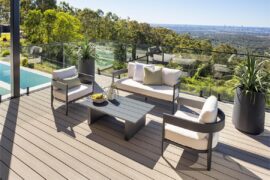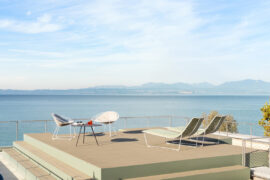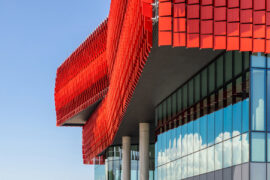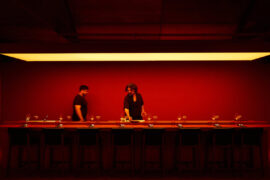Inspired by twill fabric, Doshi Levien has created a collection of rope for Kettal with a playful tonal dimension.

July 18th, 2017
There are many reasons why Kettal is one of the world’s leading outdoor furniture companies, but at the heart of the matter is a bold and thorough creative strategy. “They’re inventing the raw materials they use – that’s the difference,” says Jonathan Levien, one half of design studio Doshi Levien. “They’re not selecting some ropes from here, some fabrics from there. They’re creating those raw materials. That gives Kettal huge scope for brand clarity,” he says.
In addition to creating highly sculptural furniture pieces for the Spanish brand, Doshi Levien has also created textiles and colours for metal coatings. Now they add rope to their portfolio with Bela. The designers took inspiration from fabric, creating a twill weave structure for Bela that allowed them to play on the tonal differences between colours at a very fine scale.
“Bela is a three-dimensional form of the very fine diagonal lines you get with a twill weave structure,” explains Levien. From a distance the 18 colours in the Bela ropes collection look rich, and on closer inspection the fine two-tone effect is visible. “There’s a melange in all the materials we’ve created,” says Nipa Doshi.
The name Bela was taken from the Hindi word for ‘a flowering creeper’ – an apt descriptor of the product’s delicate interwoven structure as well as its potential to twine its way around furniture from the Kettal catalogue. In Doshi Levien’s Cala collection, for example, Bela rope is used to weave the latticed backrest of the collection’s chair, armchair, dining chair and sofa – framing users with a dramatic sunburst pattern while maintaining contact with the natural elements.
In Singapore, Kettal is carried by P5.
INDESIGN is on instagram
Follow @indesignlive
A searchable and comprehensive guide for specifying leading products and their suppliers
Keep up to date with the latest and greatest from our industry BFF's!

At the Munarra Centre for Regional Excellence on Yorta Yorta Country in Victoria, ARM Architecture and Milliken use PrintWorks™ technology to translate First Nations narratives into a layered, community-led floorscape.

For a closer look behind the creative process, watch this video interview with Sebastian Nash, where he explores the making of King Living’s textile range – from fibre choices to design intent.

It’s designed for how you live, not just for how it looks.

Arper expands its outdoor offer by re-engineering some of its most recognisable indoor pieces for life outside.
The internet never sleeps! Here's the stuff you might have missed

In the New Year, architecture will be defined by its ability to orchestrate relationships between inside and outside, public and private, humans and ecology, and data and intuition.

Located in the former Madam Brussels rooftop, Disuko reimagines 1980s Tokyo nightlife through layered interiors, bespoke detailing and a flexible dining and bar experience designed by MAMAS Dining Group.